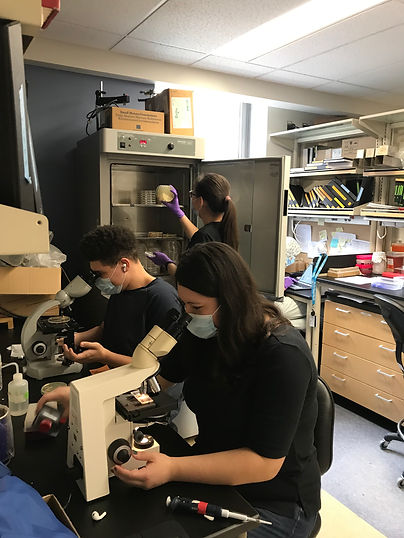
Areas of Study
The Arndt Lab utilizes a modern mix of genetic, genomic, and biochemical approaches to understand the proteins that control gene expression in eukaryotes. To do so, we take advantage of Saccharomyces cerevisiae (budding yeast) as a powerful model system.
Transcription
In all organisms, the proper control of transcription is critical for normal growth and development. At each stage in the transcription cycle in eukaryotes, RNA polymerase II is subject to multiple regulatory inputs. We are especially interested in the fascinating interplay between transcription and co-transcriptional processes. Much of our focus is on transcription elongation, the stage in the transcription cycle in which RNA synthesis is coupled to RNA processing and modification of the chromatin-assembled genome. We study transcription elongation factors that function at the interface between transcription and co-transcriptional processes. These proteins are essential for controlling the accuracy and efficiency of transcription and preventing widespread dysregulation of gene expression.

Chromatin

Gene expression occurs in the context of chromatin --- the packaging of DNA around histone proteins in the form of nucleosomes. We are interested in the mechanisms and proteins that couple changes in chromatin state to active transcription. These proteins include histone modifiers that promote deposition or removal of conserved histone modifications and chromatin remodeling enzymes that maintain nucleosome spacing on active genes through nucleosome sliding or assembly. We are also exploring the coordination among different chromatin modification pathways and how these, together, ensure proper packaging and expression of the genome.
Some Current Research Questions
What are the functions of the RNA polymerase II transcription elongation factors?
The Paf1 complex
The evolutionarily conserved Polymerase-associated factor 1 complex (Paf1C) is a transcription elongation factor that associates with RNA Polymerase II on all active genes in the eukaryotic genome. The five subunits of the Paf1 complex (Paf1, Ctr9, Cdc73, Rtf1, and Leo1) have all been implicated in a variety of co-transcriptional processes necessary for cellular health. Understanding the functions of this critical transcription elongation factor will provide key insights into how genes are expressed and how this process is disrupted in various human disease states, including multiple types of cancer. Using multi-disciplinary approaches, we are studying how Paf1C regulates the elongation properties of RNA polymerase II, why Paf1C is required for the deposition of a set of histone modifications that are molecular hallmarks of active genes, and how Paf1C impacts the transition from transcription elongation to termination.

The interplay between Paf1C and multiple events during gene expression
Spt5
Conserved from bacteria to humans, Spt5 (also known as DSIF in humans) plays a central role in regulating transcription elongation. This essential, multi-domain protein interacts directly with RNA polymerase II and other elongation factors, including Paf1C, which it recruits to the core elongation machinery. Using a combination of genomic, proteomic, and genetic approaches, we are investigating the functions of Spt5, with a particular focus on how it coordinates transcription with co-transcriptional events and how it directs the assembly of the core elongation machinery.

Transcription elongation factors direct co-transcriptional processes
How is chromatin structure maintained during transcription?
Chromatin remodeling enzymes
Regulated gene expression requires both the disassembly of nucleosomes in the path of RNA polymerase II and the reassembly of nucleosomes in its wake. Failure to reset chromatin after disruption by transcription leads to inappropriate access to the genome and a deregulated transcriptome. How are nucleosomes reassembled and repositioned during this dynamic process? One key factor is the nucleosome remodeling enzyme Chd1, which belongs to a large, conserved family of enzymes that use ATP hydrolysis to slide nucleosomes into their proper positions. We discovered that Chd1 is directed to actively transcribed genes partly through its interactions with the Paf1C transcription elongation complex. Using our comprehensive toolset and an exciting collaboration within the Hainer lab, we are probing the Chd1-Paf1C interaction and its impact on chromatin structure genome-wide both in yeast and in mammalian cells, where its functions are critical for the prevention cancer.

Chd1 chromatin remodeler is required for maintaining chromatin structure
Histone modifications
Through the covalent attachment of small chemical groups or even small proteins, like ubiquitin, to histones, eukaryotes have evolved a dynamic strategy to regulate all DNA-templated processes ranging from transcription to DNA repair. The enzymes that deposit and remove these modifications work with high specificity and coordinate with the various molecular “machines” at the heart of molecular biology, including the RNA polymerase II elongation complex. We discovered that Paf1C directly interacts with one such epigenetic modifier, a ubiquitin conjugase that adds a ubiquitin molecule to histone H2B during active transcription, thus coupling H2Bub to gene transcription. H2Bub then initiates a cascade of other highly conserved histone modifications. We are studying how H2Bub and downstream histone modifications regulate the stages of transcription and how they coordinate with other chromatin modifications, including a histone variant, to make sure gene expression is precisely controlled.
